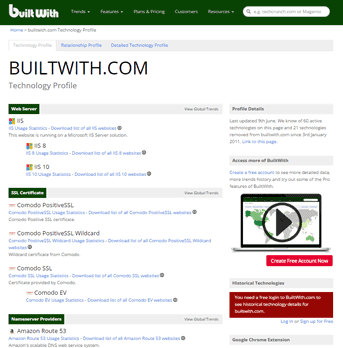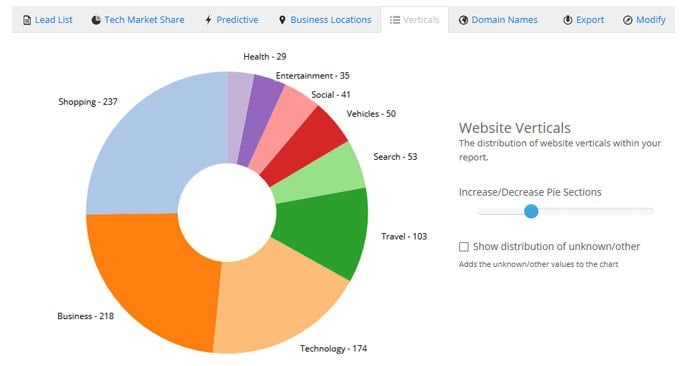
TL; DR: Gary Brewer wasn’t interested in starting a company — he just wanted to know what technologies web developers and designers were using on their websites. Gary created a tool to satisfy his curiosity and put it online. Today, BuiltWith recognizes more than 14,000 web technologies and indexes a quarter of a billion websites to let people see which sites use which hosting company, content management system, or analytics program. Subscribers, however, can filter their results by geographic location, amount of traffic, and retail categories to generate leads and track customers.
Gary Brewer is essentially a 1-man global business. Each day, he works three different jobs for the same company: He is the Founder, the Lead Developer, and the Customer Support Team. His company, BuiltWith, is well known for sharing what technologies and services a website uses, but it also generates leads and provides business intelligence for thousands of paying customers.
The modest, reluctant entrepreneur has a very matter-of-fact outlook on why he’s kept his wildly successful company almost entirely to himself: it’s just easier and faster this way.
“I consider myself very risk-averse, so I’m not an entrepreneur in the sense that I wanted to build something and get loads of money in funding to build it,” Gary said. “It’s a tool that’s going to grow over time. It’s actually quite easy to maintain, and I’ve been doing the programming side of things for almost 20 years. In terms of building new functionality and fixing things, it’s super quick. I can do it so quickly that it would be slower to outsource things.”
What Began with Curiosity and a Convenient Domain Became a Business
Almost 10 years ago, Gary was going to meetups with other like-minded lovers of startups, technology, and development. Instead of the businesses and ideas being thrown around, however, Gary was more interested in how their websites were created. He’d right-click on a site to view the source code and see what platforms companies were using.
Gary’s curiosity habit was forming when Google Analytics was just coming out of beta testing. Only experienced developers could learn about the inner workings of websites at the time, so Gary thought it might be a good idea to make the information more accessible to the masses.
“It wasn’t a business idea, it was just an idea for a fun website that would tell you what sites are built with,” he said. “It just so happened that BuiltWith.com was available, so that’s what I called it.”
Early Coverage Grabbed the Attention of Developers and Web Folks
Gary launched BuiltWith in July 2007. A month or two later, ReadWrite and several other major blogs heralded BuiltWith’s existence, giving Gary’s company initial traction and SEO.
“Those articles were just lucky starts, and that really helped to cement BuiltWith in people’s minds,” he said. “From there, it spread mostly by word-of-mouth. It’s a cool thing to be able to show someone, so that has helped spread the word. It certainly wasn’t me doing anything.”

Gary Brewer grew BuiltWith into a lead-generation tool and business-intelligence gatherer.
BuiltWith made it to the top spot on Digg early on, and Gary took a picture of the screen when his analytics tool showed that a whopping 500 people had come to his site.
“There was never any defining or big moment, but there’s a lot of good feedback that I still get,” he said. “Even if it says, ‘I’m not going to pay for anything, but this is pretty handy,’ I like that story because it’s quite nice to be helpful.”
Suddenly, People Wanted More Features — And Were Willing to Pay
As online shopping, social networking, and analytics grew, Gary devised more ways to segment and track the different technologies websites used. More users came to BuiltWith, and more users offered to pay for specific lists and filters.
Although individual site searches will be free forever, Gary created subscriptions that currently range from $295 to $995 per month and allow customers to search for certain technologies, retail categories, and keywords.
“It wasn’t really my idea to start making the pro tools or anything like that,” he said. “It was the feedback from people saying, ‘This is what we want.'”
The Technical Stuff: What BuiltWith is Built With
Gary’s mantra when programming BuiltWith is to simply “stick with what you know.” He did a lot of work in Microsoft platforms while in college, “so I basically just stuck with Microsoft-related products the whole time,” he said.

BuiltWith uses IIS servers and Comodo SSL certificates.
Gary shares the advice with anyone starting a website or business: “If you keep changing things to the latest and greatest product, you never really fully understand how it works, and it’ll be much harder to do something and continue it.”
“Basically, we use the fastest tools with the lowest costs. It has achieved the most efficient way to index the Internet.”
With more established technologies and coding languages, “any problem you have, someone has already had it,” Gary said. Developers can quickly find a solution on Stack Overflow or Google, while it might take weeks for someone to solve a new problem with a new technology.
Familiar, Fast, Low-Cost (and Not Necessarily Cool) Technology
BuiltWith’s frontend is ASP.NET. The MongoDB database is spread across multiple servers, while the user accounts are in Microsoft SQL servers. All the data and hosting goes through French company OVH. DNS lookups and SSL certificate lookups are done using Ubuntu.
He admits to using SVN for version control even though “I know it’s not the coolest one,” he said with a laugh. Since Gary has been the only one committing updates to BuiltWith using SVN, “it’s really more for if I make a mistake, then I can go back and fix something.”
“Basically, we use the fastest tools with the lowest costs,” Gary said. “That’s just how it has grown since it has been bootstrapped. It’s achieved the most efficient way to index the Internet.”
Hordes Of Virtual Servers Crawl Across The Internet
To keep track of the Internet, Gary and BuiltWith will fire up thousands of Amazon’s Elastic Compute Cloud, or EC2, virtual servers. The servers run Gary’s custom C# (C-Sharp) code.
“We’ll have something like 2,000 servers running for 24 hours,” Gary said.
5 Features of BuiltWith That You Should Be Taking Advantage Of
Whether they pay or not, BuiltWith customers tend to share the same sense of curiosity that inspired Gary. At its core, BuiltWith is for people who want to know what peers, competitors, or simply interesting websites are using. It could mean the difference between using Squarespace or WordPress, or exposure to something completely new.

Websites found in BuiltWith reports can be filtered by traffic, location, domain extensions, and more.
Gary calls BuiltWith’s original service of technology tracking (what server, email, or hosting providers a site uses) “fantastically simple to do.” Products like Google Analytics or Shopify use specific JavaScript variables or insert the brand name into the source code. Most of the paying BuiltWith customers, however, were more interested in the eCommerce component of companies rather than the technologies. Numerous filtering options enable companies to narrow their search results to specific audience segments and targets.
1: Lead Generation
Most customers with subscriptions use BuiltWith as a lead generation tool for their company, according to Gary: “If you were a company that did optimization for websites and you specialized in sites with WordPress, you could ask for a list of all the people in your region with WordPress sites posting at least weekly and spending more than $100 per month. That could be your starting point of people that might pay for your tool.”
Businesses might also use BuiltWith to look at their competitors. Beyond gauging the size of a competitor’s customer base, a business could target customers differently based on how long they’ve used the competitor.
“You can build this list of 100,000 sites to start with. Once you filter it down to the ones that are worth reaching out to, it might be just 100,” Gary said. “But you know those 100 websites are likely going to be your customers because they match your criteria.”
2: Customer Analytics
Owners of the technologies themselves, such as Magento, MailChimp, Amazon, and Rackspace, use BuiltWith to find out who their customers are and how they might better serve them.
“The nature of their tool might not have any callback to their own servers,” Gary said. “Even those that do, getting that list of customers can be so hard. It’s often easier to buy it from BuiltWith.”
What’s more, companies can filter the list of customers to see who is using the free version of their tool but spending lots of money on other technologies for their website, for example. “They’re the customers worth reaching out to to try to get them to upgrade to the paid versions,” Gary said.
3: Business Intelligence
Perhaps the most interesting user segment, Gary said, is the hedge funds and investors that use BuiltWith’s profiles to measure a company’s potential value or find companies looking to go public. Investors can find out how many customers a technology company has, and whether that number is trending up or down. BuiltWith pulls the curtain back and reveals basic information about how viable or profitable an investment might be.
4: Retail Categories and Keyword Filters
Beyond the shopping cart software programs used, BuiltWith customers wanted more eCommerce information about the companies profiled. The requests led Gary to build out a feature allowing users to filter results based on retail categories.
“Retail categories aren’t as easy to do, and it’s not 100% accurate,” Gary said. “If it’s a motorcycle t-shirts store, is that an automotive category or a clothing category? Keywords can cause things to be a bit more tricky, and we try to tell people that.”

Keyword or category filtering helps BuiltWith customers drill down to the most relevant results.
However, BuiltWith customers can now search for all sites selling luxury cars or kitchenware, and then filter by technology used — all because they asked for it. Who is selling designer bags and hosted at Rackspace? Who sells sportswear using Magento’s eCommerce platform?
5: Relationships Between Websites
The newest feature in the BuiltWith queue shows users the relationships between websites, Gary said. By capitalizing on BuiltWith’s immense database, users can see what websites have shared assets or are related through a common analytics ID or IP address, for example. Customers can use the data to find security gaps (what websites are sharing analytics with each other) as well as a company’s clients or side projects.

To show relationships among websites, Gary looked at Hilary Clinton’s and Donald Trump’s analytics IDs.
Showing off the new tool, Gary examined the web presences of presidential candidates Hilary Clinton and Donald Trump in a BuiltWith blog post. The relational data shows a few unrelated websites that lifted code from Clinton’s site, while two satirical Trump sites have leaked analytics back to the Republican candidate’s campaign.
Minimal Staff Means the Founder Handles Customer Support
Gary used to have a beautiful office in Manly, Australia, that overlooked Sydney Harbour, “But it was a waste of money, really,” he said. “There’s no need for me to be in there.”
BuiltWith now has an office in Sydney for monthly meetings and the limited number of employees who take care of the things Gary doesn’t terribly like, such as the accounting and the social media marketing. There’s no sales team or support team. That’s Gary.

Although the BuiltWith offices are lovely, Gary more commonly works from home.
He allots a couple of hours each day for dealing with about 1,200 monthly support tickets in ZenDesk. His reply comes about 30 hours after a ticket is first submitted — right in line with industry averages. By the time he gets to them, most questions Gary receives are addressed in about 10 seconds by sharing a link from BuiltWith’s knowledge base.
“If someone has a problem I’ve never come across before, I’ll write a knowledge base article, make a 20-second video to show the exact steps, and then kind of remember it’s there,” he said.
One of the bigger support topics Gary finds himself dealing with frequently is customers who want to unsubscribe. While most business leaders want to hold tight to every customer, Gary is now trying to show them the door. The site each month garners two million pageviews and about 500,000 unique users — and Gary is trying to make the process of unsubscribing easier.
“When I built the subscription model, my mindset was more on how can I keep people from unsubscribing,” he said. “Now, it’s more like let’s make it as easy as possible so there’s less work for me to do. I can spend more time doing more enjoyable things like building new tools.”
Looking Ahead and Beginning to Share the Workload
BuiltWith remained Gary’s side project for four years. Even as the site made $40,000 a month, he only worked on it during evenings and weekends — he liked working for a good boss and knew how unstable startups could be. Andrew Rogers, a second-degree LinkedIn connection and fan of the site, asked Gary to coffee during that fourth year to pick his brain. They traded ideas and kept talking for months.
Eventually, Andrew convinced Gary to work full time on BuiltWith and “begged (his) way into working for (Gary) for equity only.”

Gary (left) and Andrew’s (right) partnership keeps BuiltWith moving forward.
“It’s good to have an outside view of things,” Gary said, adding that he and Andrew meet about monthly. “He has been tremendously helpful.” Even though he appreciates having someone to work with, Gary still isn’t sure about when he’ll start sharing more of the workload. (Oh yeah, he also has a new baby at home who was 10 days old when we talked to him.)
“I think it’s probably getting to that stage where it might happen sooner or later,” he said about hiring more people while admitting he fears an employee leaving quickly after Gary spent the time to train him or her.
“I need to do it,” he reminded himself. A bit of a pause, then: “At some point.”
HostingAdvice.com is a free online resource that offers valuable content and comparison services to users. To keep this resource 100% free, we receive compensation from many of the offers listed on the site. Along with key review factors, this compensation may impact how and where products appear across the site (including, for example, the order in which they appear). HostingAdvice.com does not include the entire universe of available offers. Editorial opinions expressed on the site are strictly our own and are not provided, endorsed, or approved by advertisers.
Our site is committed to publishing independent, accurate content guided by strict editorial guidelines. Before articles and reviews are published on our site, they undergo a thorough review process performed by a team of independent editors and subject-matter experts to ensure the content’s accuracy, timeliness, and impartiality. Our editorial team is separate and independent of our site’s advertisers, and the opinions they express on our site are their own. To read more about our team members and their editorial backgrounds, please visit our site’s About page.

